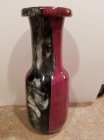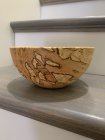I’ve had some time to use both and thought I would share my experience to help other turners who might be interested in adding a sanding paste to their repertoire.
Shipping and customer service goes to Ack’s. I’ve ordered from The Walnut Log a few times and the shipping has been a little inconsistent. The last order of Yorkshire grit took over three weeks to ship. The Ack’s shipped the next day. I’ve ordered other items from The Walnut Log that shipped quicker, so it could have been an inventory issue.
The Ack’s is very thick, I use Scott’s shop towels and the paper towels tear during application with the lathe off. With the lathe running, the paper towel catches and tears easily at first.
The Yorkshire grit goes on much easier and comes off much better. Definitely easier to use.
The finish is more matte with the Ack’s and more shiny with the Yorkshire grit. Neither affected the final finish. Both products look exactly the same, you wouldn’t be able to tell the difference if the containers were the same.
After using Ack’s for the first time, I did not look forward to using it again. Although to be fair, I gave it four chances. I just couldn’t get past the consistency, it was unpleasant to wipe it on and equally unpleasant to remove it. For that reason, Yorkshire grit is my preference.
This is just my experience and personal preference. I will say that both products worked as advertised.
Shipping and customer service goes to Ack’s. I’ve ordered from The Walnut Log a few times and the shipping has been a little inconsistent. The last order of Yorkshire grit took over three weeks to ship. The Ack’s shipped the next day. I’ve ordered other items from The Walnut Log that shipped quicker, so it could have been an inventory issue.
The Ack’s is very thick, I use Scott’s shop towels and the paper towels tear during application with the lathe off. With the lathe running, the paper towel catches and tears easily at first.
The Yorkshire grit goes on much easier and comes off much better. Definitely easier to use.
The finish is more matte with the Ack’s and more shiny with the Yorkshire grit. Neither affected the final finish. Both products look exactly the same, you wouldn’t be able to tell the difference if the containers were the same.
After using Ack’s for the first time, I did not look forward to using it again. Although to be fair, I gave it four chances. I just couldn’t get past the consistency, it was unpleasant to wipe it on and equally unpleasant to remove it. For that reason, Yorkshire grit is my preference.
This is just my experience and personal preference. I will say that both products worked as advertised.



